From the River Rhine to the River Main and the Odenwald Forest
12 Towns in 2.5 Years
In this blog post (hyperlink), I wrote about how it took us almost four years to complete one section of Deutsche Fachwerkstrasse or German Half-Timbered House Road.
We recently completed a second section of the road – there are seven total – called “From the River Rhine to the River Main and the Odenwald Forest”.
It’s 203 kilometers long, and it took us about two and a half years to see all twelve of its towns.
The first town we visited was Hanau-Steinheim, back in November 2014.
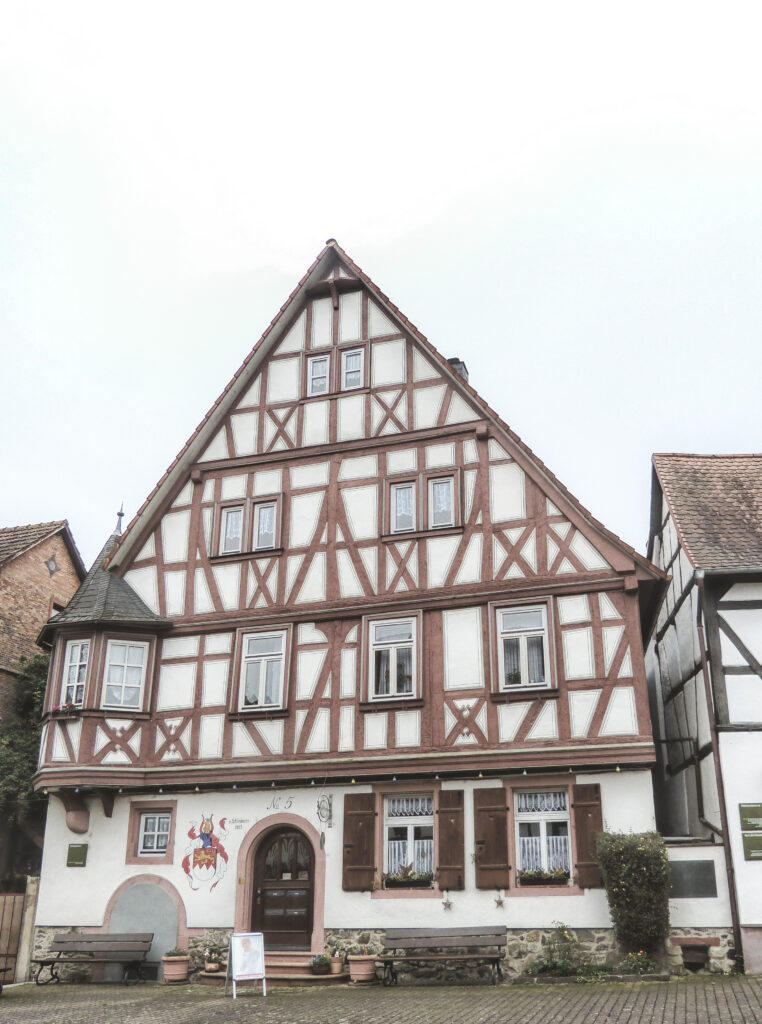
The Schönbornhof was originally owned by the Schönborn family. The date on the building is 1563. It later served as a schoolhouse for most of the 19th century.
The town was just setting up its little Christmas market when we were there.
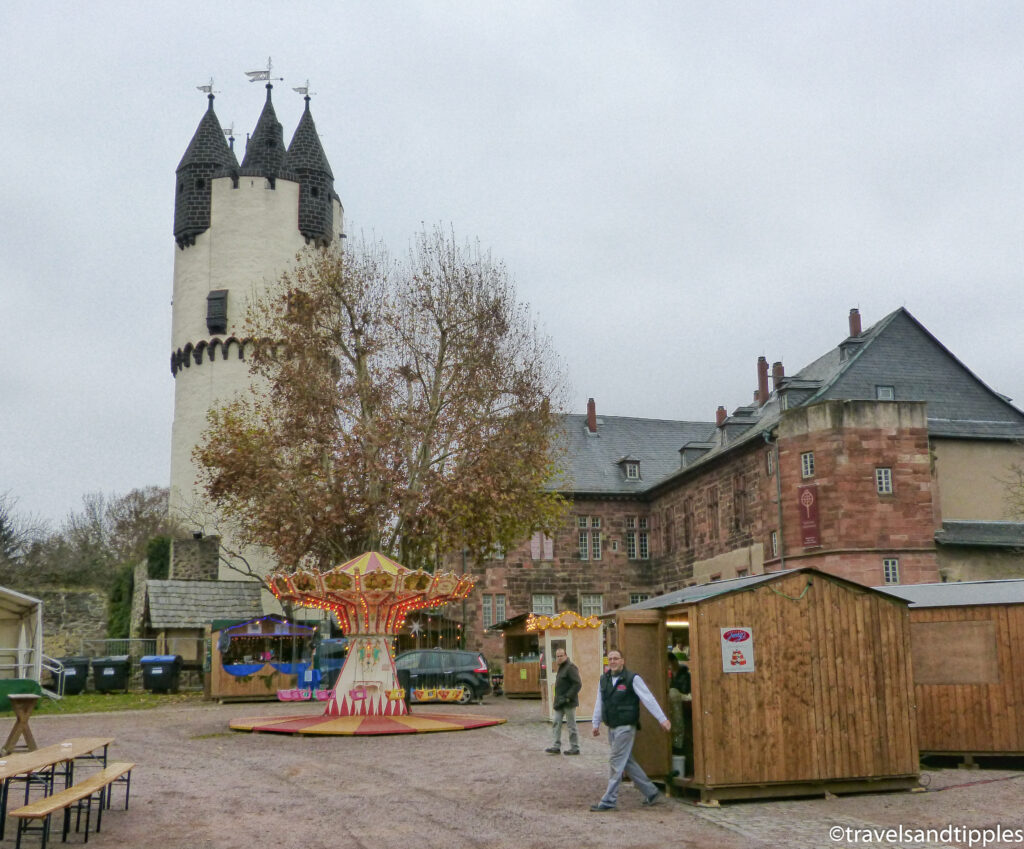
It was in the courtyard of the Steinheimer Castle, which was built in the 13th century and now houses a museum.
The tower is the Bergfried or the keep, which is where the residents would have fled if enemies had captured the castle.
There is a lovely herb garden at the castle complex right next to the River Main.

As if being on the German Half-Timbered House Route wasn’t enough, the town is also on the Hessian Apple Wine Route.

We did see one odd little thing in Hanau-Steinheim.

What the heck is a U.S. mailbox doing there?
The same day we went to Hanau-Steinheim we also went to Dreieich. The two towns are only about 25 minutes apart.

This town had some really cute half-timbered houses and lots of charming little shops and restaurants.
You can see that they were gearing up for Christmas as well.
We browsed some of the shops in town and I was tempted to buy this.
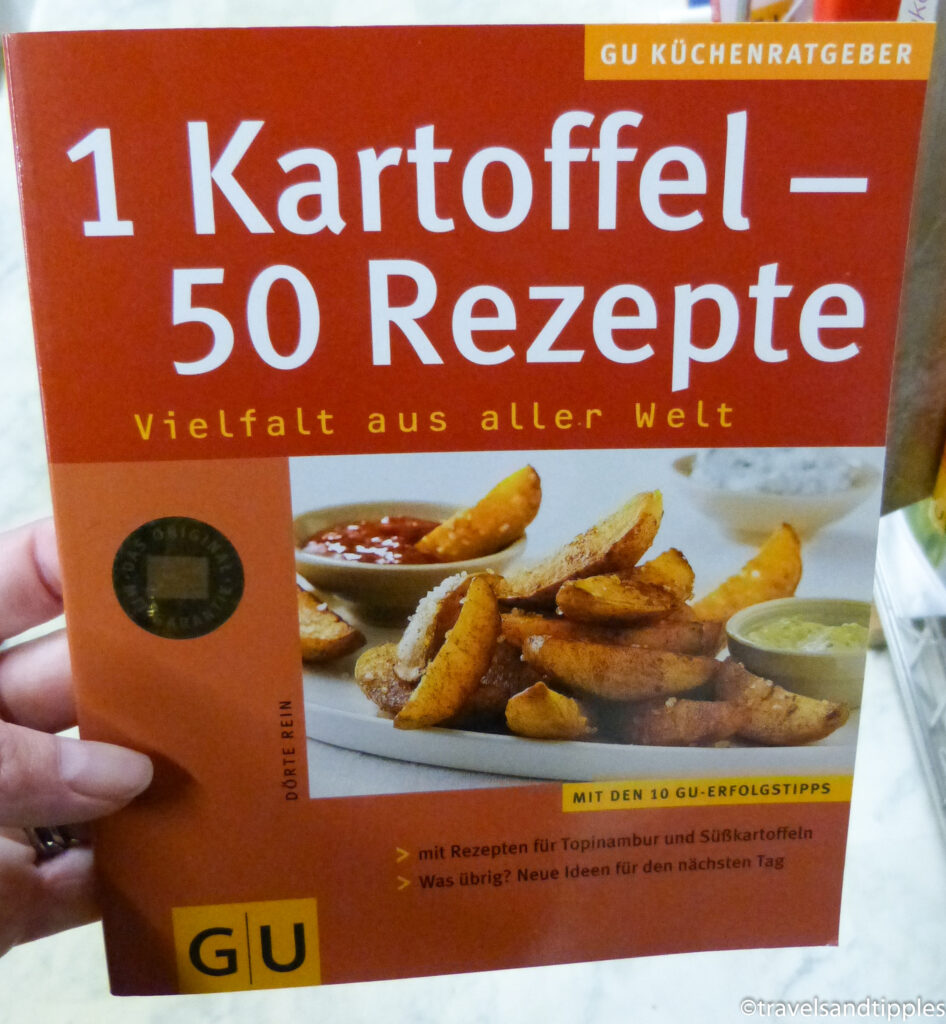
Only in Germany would they have a book called “1 Potato, 50 Recipes”.
This colorful house was built in 1616.

The five-sided tower that juts out houses a staircase.
Naturally Dreieich had a castle as well.

The Hayn Castle, whose origins date back to the 12th century, is now in ruins.
Despite the chilly day, we saw a bridge and groom having their photos taken at the castle!
The first weekend of 2015 we found ourselves in Trebur.
Trebur was a significant town in its day because of its Imperial Palace.
More than 50 kings stayed there between the 9th and the 11th centuries. The German King Henry IV, who was also the Holy Roman Emperor for a time, was both crowned king and married in Trebur.
Although he was the last king to visit there and Trebur lost some of its importance, it’s still worth a visit for non-royals today.
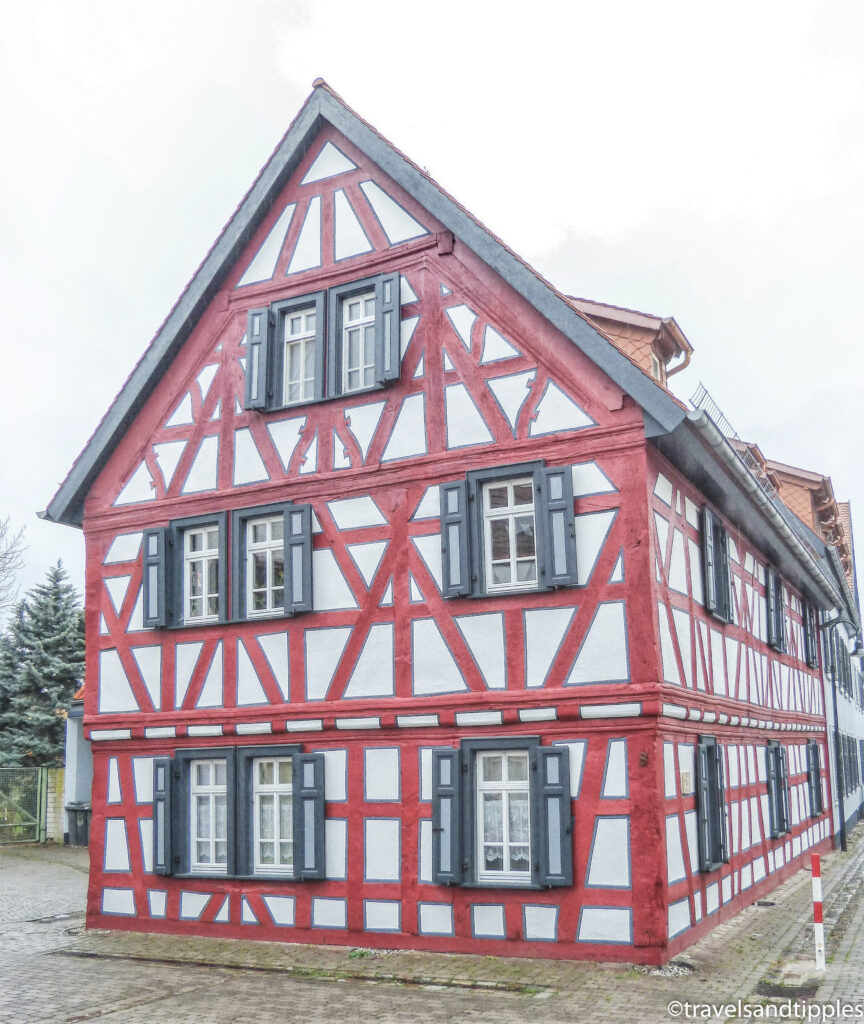
That’s one of the more well-known houses in town and it’s called The Red House, for obvious reasons.
It was built around 1680. Each region and town on the Half-Timbered House Road has a style of building typical to that area, and this one is typical of Trebur.
This multi-colored house still had the Christmas spirit going.

One of the things that amuses me when we’re traveling is the variety of vending machines we run across.
You just wouldn’t believe what you can buy from a vending machine in some places.
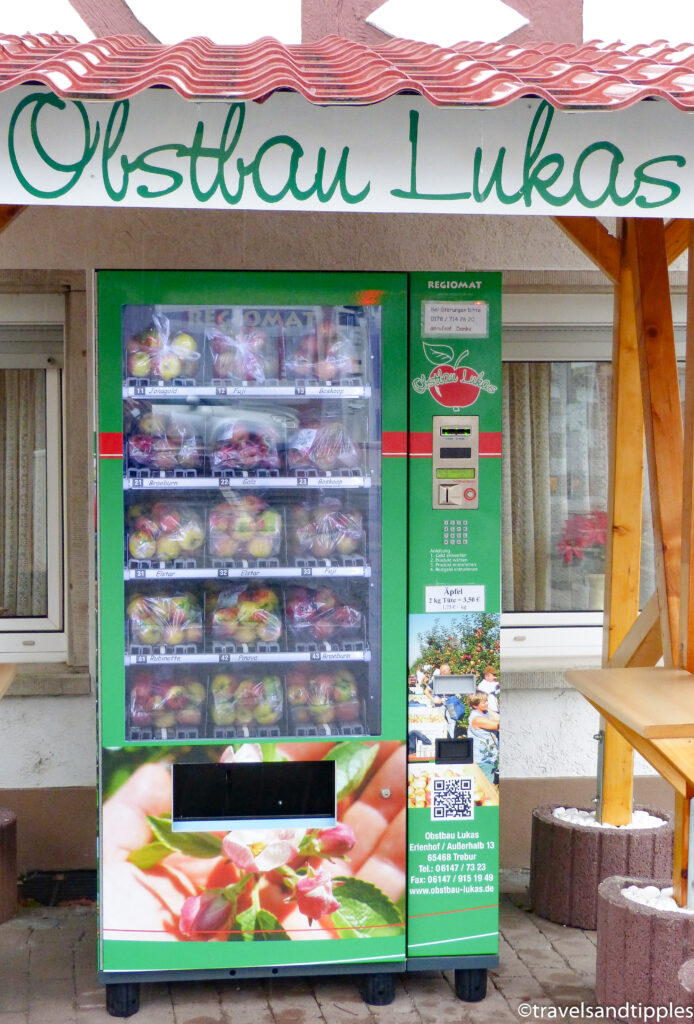
In Trebur you can buy apples. At the time of our visit, a 2 kilogram (just under 4.5 pounds) bag was 3.50 Euro.
Not every house you see along the route is perfect.
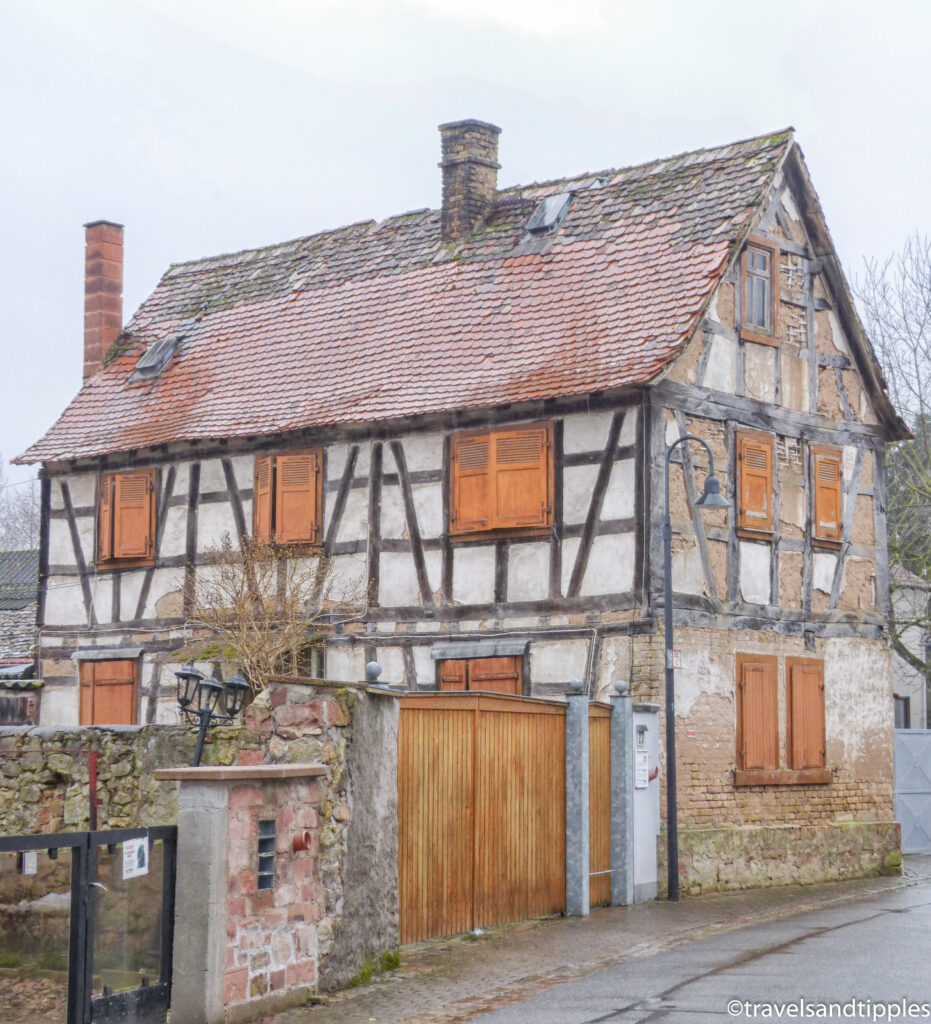
In that photo you can see what the half-timbered houses look like underneath the quaint exteriors.
This is the last house we saw on our tour.

You might have noticed that the weather was wet, gray and gloomy that day. It was actually raining pretty heavily by the time we left.
We actually went back the next day because there were two sights we missed because of the rain.
Architecture is not the only reason we love going to towns on the Half-Timbered House Road. There’s almost always some other fascinating tidbits about the town.
In the case of Trebur, this is one.

There is a lovely path along the Rhine River that leads you to the Zeppelinstein.
On August 4th in 1908, Count Ferdinand von Zeppelin himself made an emergency landing at this spot in the aircraft named after him.
Everyone on board survived and they actually continued their journey later that day.
The other thing we wanted to see has a much sadder history.
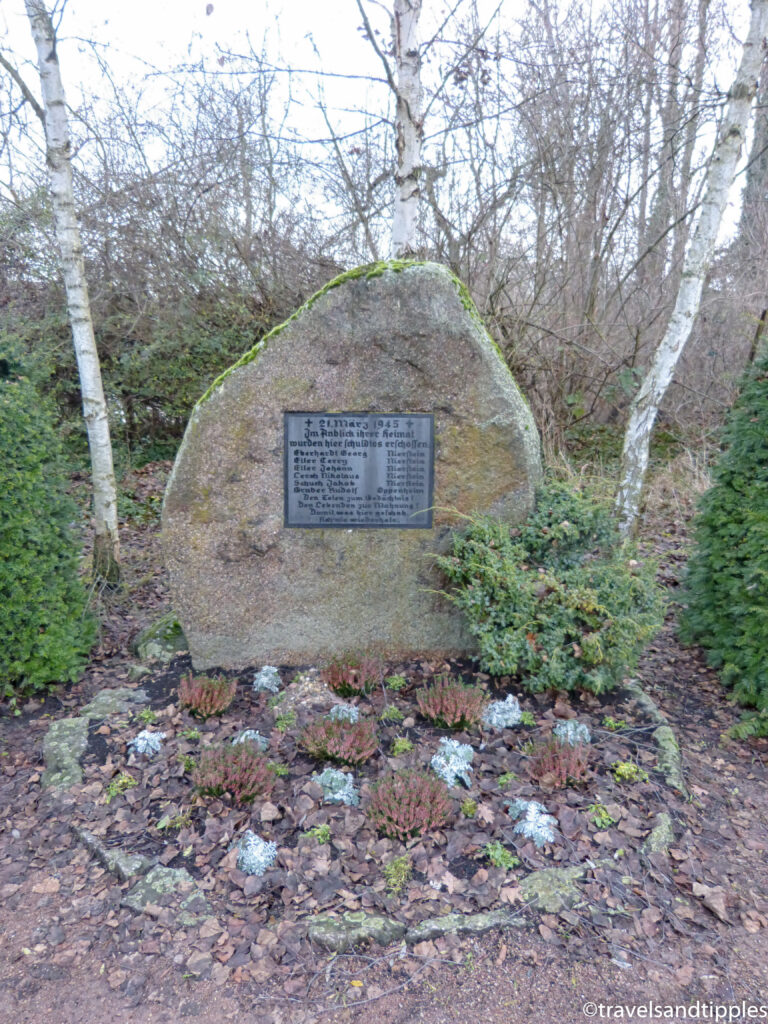
On March 21st in 1945, just before the Americans liberated the area, six innocent people were captured by the Nazis.
They were forced to dig their own graves and then were shot to death by a 19-year old lieutenant.
There is a memorial service held here every year on March 21st.
About a month after visiting Trebur, we went to Babenhausen.
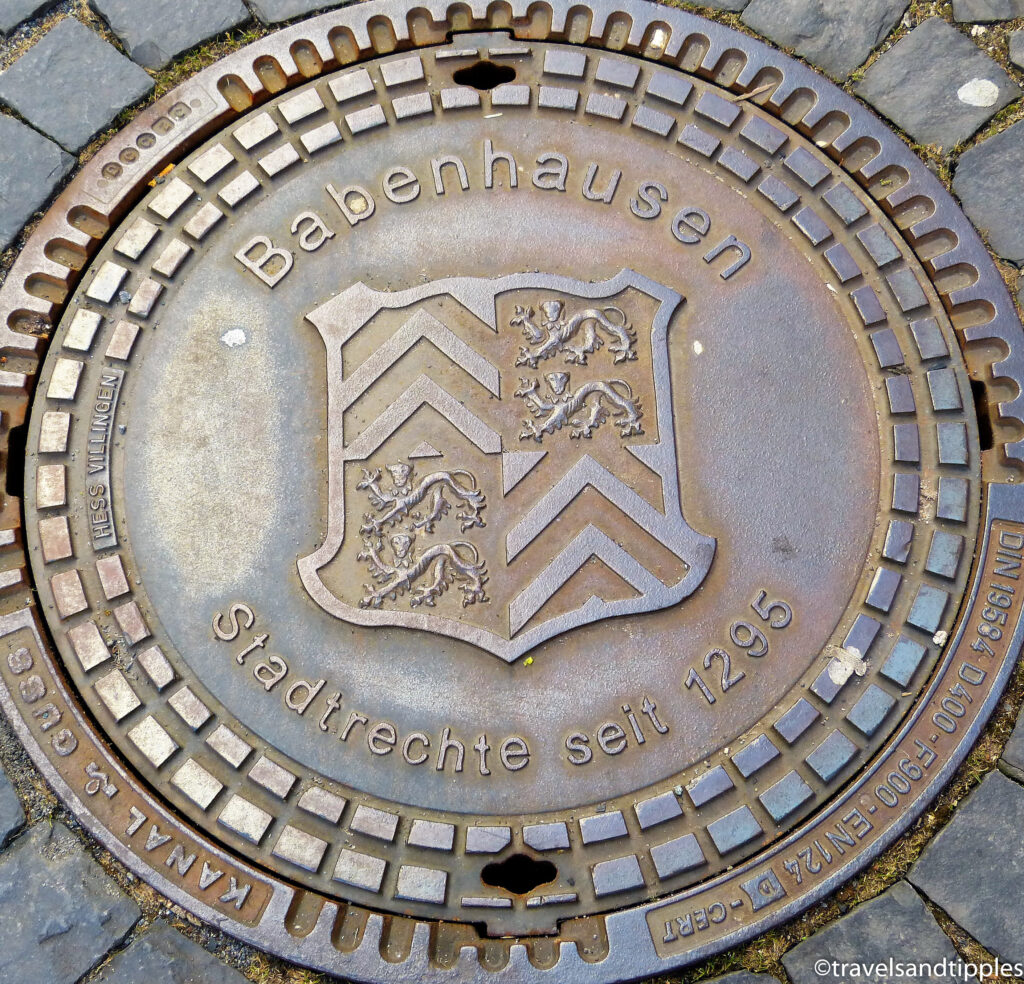
You may not know this about me, but I’m a bit obsessed with photographic manhole covers.

It always makes me chuckle when I see a half-timbered house that is centuries old, and when you look closer you see something like this “Tequila Sportsbar” sign hanging from it.
The most impressive building in town is this one, the old pharmacy built in 1774.
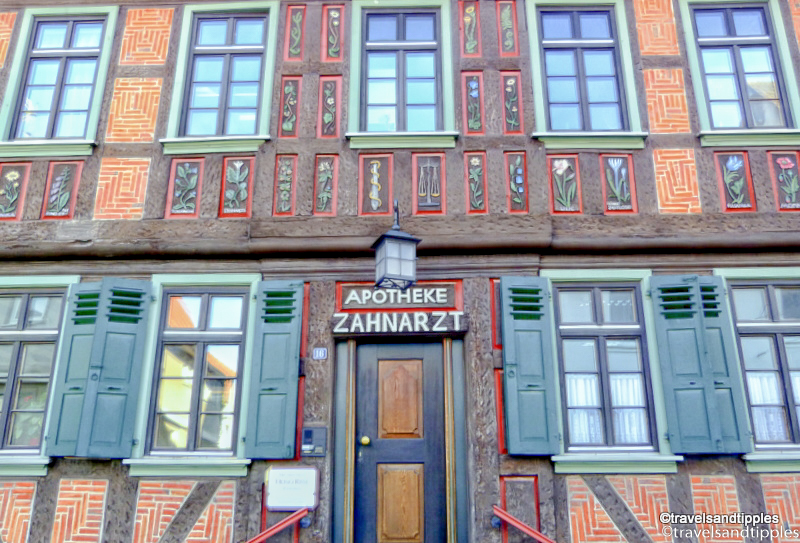
Although the colorful carvings were added much later, they really make the building stand out.
Babenhausen is one of numerous German towns we’ve visited that had some kind of U.S. military presence in the past.

You often see touching plaques and memorials like this one in those towns.
In the spring of 2015 we found ourselves in Seligenstadt.

We had been there briefly once before for an Easter market, but hadn’t really explored the town at the time.
Seligenstadt is more than 1,200 years old, and about 700 years before it was established there was a Roman military settlement there. It has quite a history.
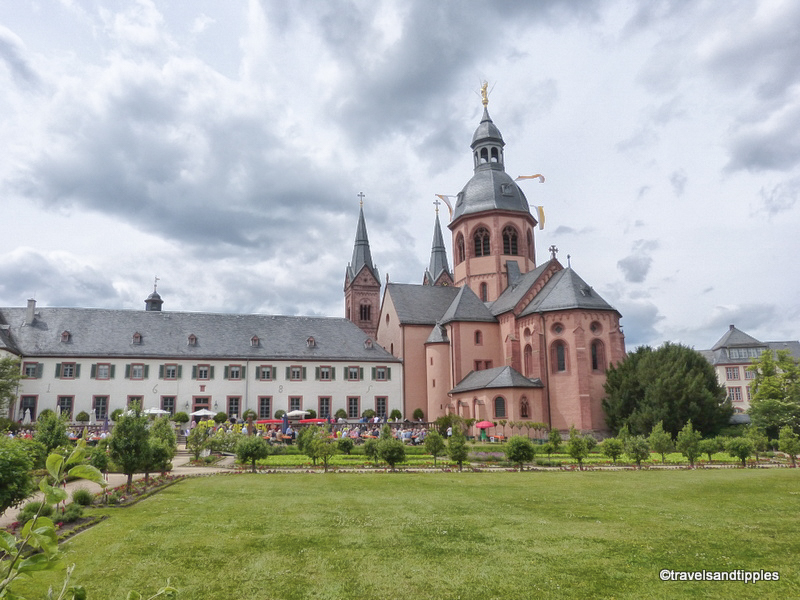
That basilica also dates back more than 1,200 years, although it was reconstructed on its 900th anniversary.
Seligenstadt is also where we saw this amazing white peacock.
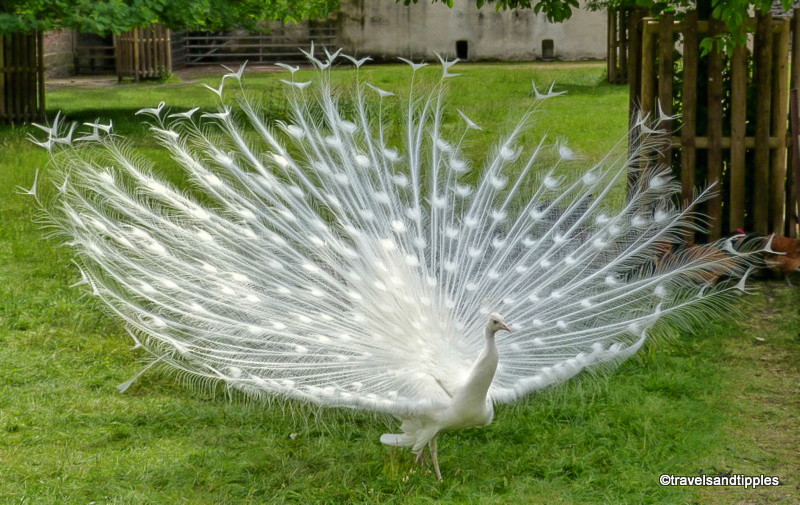
That photo is still one of my favorites.
After Seligenstadt, it was another year and a half before we visited another town on this route.
Dieburg was founded by the Roman Emperor Hadrian, as in the guy who built Hadrian’s Wall, way back in the 2nd century.

There is a museum in town exhibiting artifacts from that era.
This fun little fountain is called the Fastnachtsbrunnen.
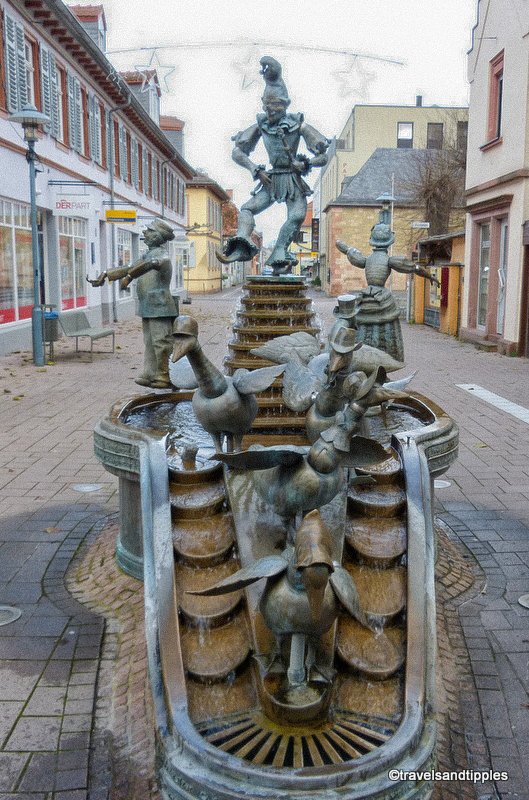
Fastnacht is the German version of Carnival, the pre-Lent festival.
All the figures on this fountain are posable – as in you can move around the arms, legs and heads – and I’m sure revelers have amuse themselves with that in all kinds of ways during the celebration.
This mill was first mentioned around the year 1500.

It was destroyed by a war in the 1600s and later rebuilt.
I’m fascinated by mills for some reason.
The Wallfahrtskirche is an amazing church.
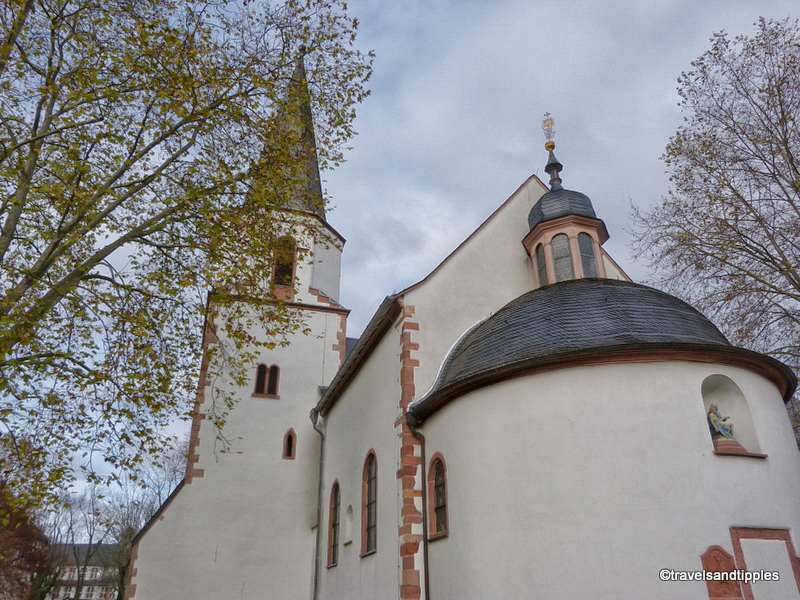
There have been six variations of churches on the site of the present church, with the earliest having been built in the 9th century.
This Pietà from the early 15th century is hollow and made mostly of leather, mortar and canvas. The arms and legs of the Christ figure are made of wood.

Pilgrims have been making their way to Dieburg to see the Pietà ever since it was created almost 600 years ago.
On New Year’s Eve in 2016 we explored the town of Miltenberg during the day.
Like Seligenstadt, we had been to Miltenberg once before – for their Christmas market – but hadn’t explored the town.
Our second visit was on a crisp, frosty day and all the holiday decorations were still up.
It made the town so picturesque that I really had a hard time choosing which photos to include with this post.

One of Miltenberg’s claims to fame is that Elvis slept there!

The building in the middle of that photo is the Zum Reisen hotel, which dates back to the year 1411.
It’s one of the oldest continuously operating hotels in the world.
Of course Napoleon slept there too.
We ended our visit to Miltenberg with a fabulous meal at this little Italian restaurant.

Doesn’t this photo make you want to eat there?
If I had to recommend a town in Germany to visit at Christmas time, Miltenberg would be one of the top choices.
In January of 2016, we checked out three towns along the route.
The first was Groß-Umstadt.
32

Look at those blue skies!
I have to say the winter of 2016/2017 was the best winter weather-wise that we’ve had in our 6 years living in Germany.
Like Dieburg, this town had a Roman settlement in the 2nd century.
There is evidence, however, that the area was inhabited in prehistoric times.
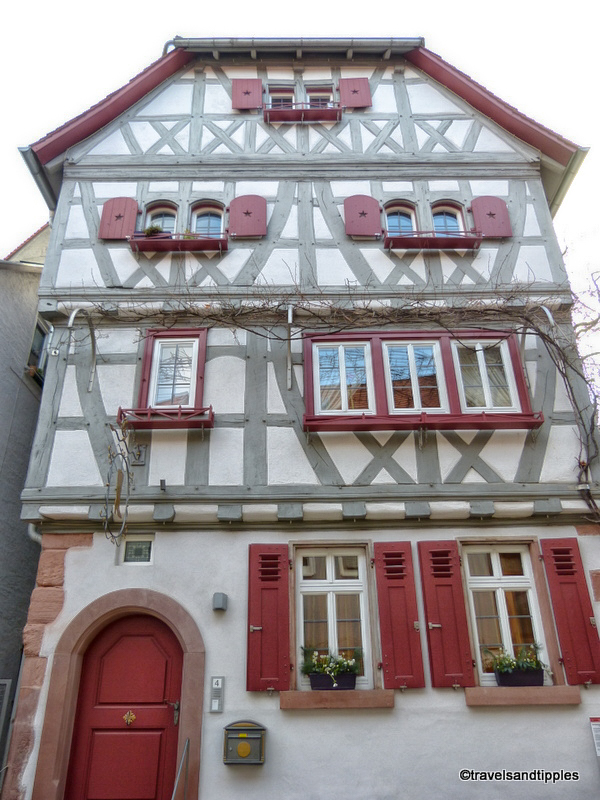
This Jägerhaus or hunter’s house was originally built in the 16th century.
I posted it because a) I like its colors; b) It’s impressive that it was built in the 1500s and c) It’s time for a little German lesson.
If Jägerhaus means hunter’s house, you can probably guess that the German word haus means house.
You can also therefore probably deduce that Jäger means hunter.
And you’re probably familiar with that dangerous German liqueur called Jägermeister, so what do you think that means?
If you guessed “Hunting Master” or something along those lines, you are correct.
Next time you’re in the vicinity of a bottle of Jägermeister, take a look at the logo.
Now you know why there’s a deer’s head on the bottle.
Back to the half-timbered house route, the next town we explored was Walldürn.
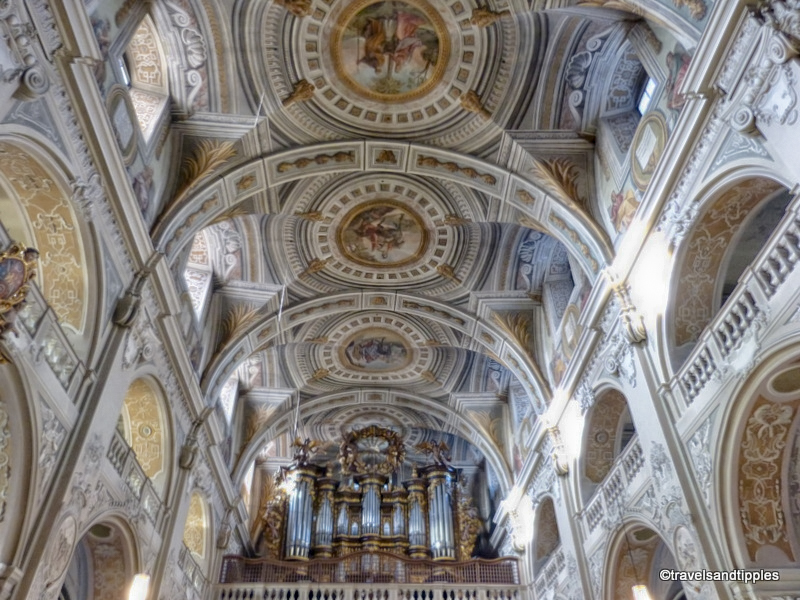
It was a cold January day and there was snow on the ground but again, the skies were stunningly blue.
One thing we did not expect to see in this tiny town was an amazing basilica.

In 1330, a priest celebrating mass spilled the chalice of wine onto the white linen cloth on the altar.
The wine supposedly left a stain in the shape of the crucified Christ, surrounded by eleven heads of Christ wearing thorned crowns.
The priest thought he would get into trouble for spilling the wine, so he hid the cloth.
Fifty years later on his deathbed, he revealed the hiding place of the cloth.
It was declared a miracle and the St. Georg church became a pilgrimage destination.
Even now, more than 100,000 pilgrims a year make their way to Walldürn.
One week later we found ourselves in Reinheim.
Unfortunately this town turned out to be a bit of a bust.
We couldn’t find any information about its sites online, we couldn’t locate any information about a tourist information office and the town itself had very few informational signs.
One of the things we were able to find on our own was this, the oldest half-timbered house in town.

Built around 1450 and now housing a restaurant, it’s called the Kalb ‘sches Haus. The name comes from the Knights of Kalb, who lived in Reinheim in the Middle Ages. The building was renovated in 2010.
There were some truly lovely examples of half-timbered houses in the town.

I was a little disappointed that we couldn’t find any information on most of them.
There is a small museum in town where we might have been able to get additional information, but unfortunately it’s open only on Sundays, and only from 2:30 to 5:00, so it didn’t fit into our timeframe.
A couple of months later, on a warm early spring day, we went back to the town of Wertheim.

I say we went back because we had been there once before, in October 2013.
It rained during our first visit so we decided to visit the town’s castle ruins another time.
That “another time” happened three and a half years later.
The earliest part of the Wertheim Castle was built in the 12th century, and it was expanded continually over the next few centuries.
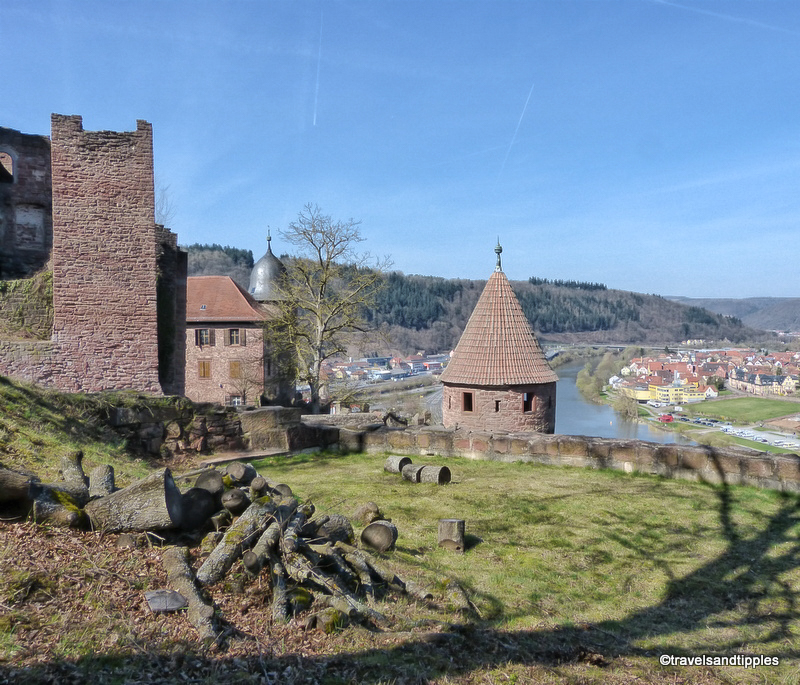
There are lovely views of the medieval town center from the walking path to and from the castle.
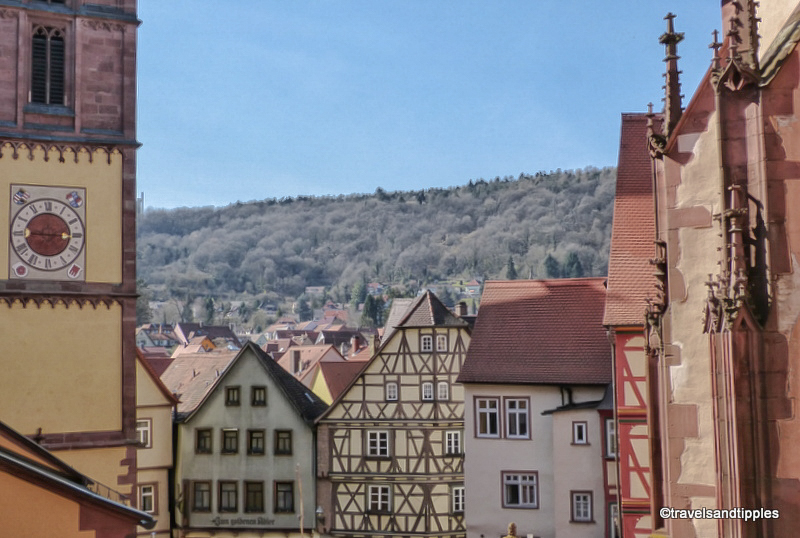
That tower actually has two clocks on it.
The side that the castle residents could see indicates only the hour; there is no minute hand.
One of the must-see points of interest in town is the high-water marks on the Kittsteintor.

The river is just to the right in the photo.
Mr. Tipples is about 6’2” and you can see that at some points the river was at least three times his height.
Can you imagine looking out that window and seeing the river at eye level?
Take a closer look at the photo and see if you can find the marking for the year 1595.
If you want a break from the castle and the half-timbered buildings and the river, you can always head over to Wertheim Village, an outlet mall with more than 100 stores.
And finally, we finished up this section of the Half-Timbered House Road with a trip to Erbach.

Erbach is truly a fairy-tale town.
This was our first view of it after parking the car – what’s not to like?

We got lucky with the weather once again and it was nice enough to sit outside and have some ice cream.

Our visit to Erbach was in early April, just before Easter, and the board is advertising a special called an Easter Egg Cup.
That’s what Mr. Tipples ended up having and it consisted of ice cream, whipped cream, chocolate sauce, little chocolate Easter eggs and almond flakes.

There was an option to add Eierlikör, a sort of alcohol-infused eggnog, which of course Mr. Tipples elected. I can’t abide the stuff, but he said it was good.
In case you didn’t know, Germans love their baskets.

In Erbach there is a Basket World (Korb Welt) store where you can buy a variety of baskets – firewood baskets, laundry baskets, baskets for pets, waste baskets, picnic baskets, basket creole, basket gumbo…..oh wait, I think that shrimp scene from Forrest Gump popped into my head and I got confused.
Back to Erbach, it’s a lovely town with fabulous examples of half-timbered houses, cute little shops and cafés, hotels and a palace. It also has a couple of museums, including the Germany Ivory Museum (Erbach was a center for ivory carving at one time).
We love going to these towns and I’m glad we still have five more sections of the German Half-Timbered House Road to explore!


